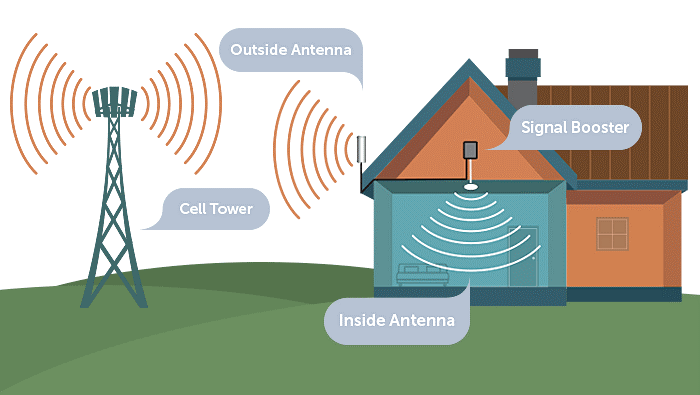It really twists one’s mind ‘do cell phone signal boosters work?’ and ‘how do mobile phone signal boosters work?’ It really taunts people, as there are lots of illegal and cheap boosters are available in the market. We will try to answer these questions in this article.
A cellular repeater (AKA cellular booster) is a Radio Frequency Communication device that can enhance 4G, LTE and 5G signal reception inside house, buildings and even vehicles.
These systems work as bi-directional amplifiers, using three key components:
- A donor antenna (to capture weak external signals).
- An amplifier (to boost the signal).
- An indoor antenna network (to rebroadcast the enhanced signal).
The “bi-directional” nature means they handle both incoming signals (from cell towers) and outgoing signals (from your phone), improving call reliability and data speeds.
How Do Mobile Signal Boosters Work?
The process involves three steps:
Capturing the Signal:
An outdoor antenna picks up faint signals from nearby cell towers.
Amplifying the Signal:
The signal is sent via coaxial cable to an amplifier, which strengthens it.
Rebroadcasting:
The boosted signal is transmitted indoors via an internal antenna, improving coverage.
Breaking It Down Further:
Outdoor Antenna Setup:
Installed on roofs or near windows, donor antennas can be omnidirectional (capturing signals from all directions) or directional (focused on a specific tower). Directional antennas often provide better signal quality in areas with weak coverage.
Signal Amplification:
The amplifier boosts both uplink (phone-to-tower) and downlink (tower-to-phone) signals, reducing dropped calls and buffering. Modern devices use automatic gain control (AGC) to prevent feedback loops.
Indoor Coverage:
Internal antennas distribute the amplified signal evenly via coaxial cables, overcoming obstacles like concrete walls or metal structures. The antenna ensures coverage throughout the space evenly, if it is omnidirectional. That's why the choice of antenna is important to get the most out of a cellular repeater.
Tall buildings and distance of cell towers have an impact cellular signal strength. As a result, the signal strength is poor in in-building and in-vehicle scenarios. The bi-directional amplifier amplifies in both uplink (phone-to-tower) and downlink (tower-to-phone) directions which makes it easier to boost faint signals in tough situations like metal buildings or fringe areas.
To add to this all the things are connected via coaxial cable to ensure that signal-blocking materials (concrete, brick or other metal) do not contribute to poor signals.
The important thing to consider here is that the whole process is dependent on available signals. You need to have some sort of signal outside for the donor antenna to capture and then amplify it and rebroadcast it inside. If there is no signal, there is nothing to boost.
Do They Actually Work? Real-World Testing
Yes—when installed correctly. Let’s look at two Australian examples:
My Touring Adventures:
A camper improved from 1 bar to 3-4 bars after installing a CEL-FI booster in their vehicle. watch the review-
Aussie Walkabout:
Testing in remote areas showed significant signal improvements. See the results-
Effectiveness Depends On
Signal Availability:
Boosters have a limitation of 65-72 dB gain, while some boosters can reach up to 100 dB gain. But, if there is no outdoor signal is available, be prepared for no improvement in signal strength.
Installation Quality:
Proper placement of antennas is crucial to avoid oscillation (feedback loops), which can lead to device shut down if not controlled by automatic gain control (AGC).
Regulatory Compliance:
In Australia, only carrier-approved boosters are legal under the Radiocommunications Act 1992. Avoid illegal devices—look for models marked as “exempt” by carriers like Telstra or Optus.
Where Are Boosters Most Useful?
Rural Areas:
In rural areas where there is a low density of houses, it is not feasible to establish base stations. Cellular boosters can be real handy in areas like those. Repeaters can extend the coverage and ensure quality calls and data.
Large Buildings:
Large buildings, offices, warehouses and metal buildings often suffer low signals inside because of the size and construction material. Repeaters are essential and effective to ensure seamless communication inside.
Underground Areas:
Basements, shopping malls and concealed areas can benefit greatly from cellular repeaters.
Vehicles:
RVs, Vans, Trucks driving in remote areas, repeater provides enhanced connectivity while on the go.
Studies shows that cellular repeaters can improve signal strength up to 32 time. This ensures the delivery of better voice, text and data performance addressing issues like weak signal, network congestion, dead zones and interferences. The benefits are multifold. Cellular boosters ensures enhanced data speeds, reliable communication, security, scalability and disaster recovery, making them suitable for businesses implementing BYOD (Bring Your Own Device) policies to boost employee productivity and customer service.
Key Benefits of Using a Cellular Booster
The practical benefit of cellular boosters are worth considering, particularly in enhancing user experience and operational efficiency:
Enhanced Signal Strength:
Users enjoy fewer dropped calls, flawless texting, and faster data speeds for applications like data streaming, video conferencing, and cloud-based services.
Extended Battery Life:
Device has to expend less energy maintaining a connection, when there is better signal strength. This contributes to extended battery life, which is lifesaving in remote areas.
Compatible with different carriers:
Cellular repeaters are generally carrier-agnostic, supporting all major Australian carriers. You can just switch carriers with an app.
Mobile Phone boosters are in fact a great solution to problems like call drops, poor data speed, and reliable text messages. They are particularly effective in fringe areas, urban dead zones and metal buildings with signal-blocking materials with applications ranging from houses to commercial spaces and vehicles. However, the effectiveness depends on a couple of things like we discussed before.
So, bear in mind about the factors that affect the performance of the device. Assess if there is at least a faint signal available, choose an approved and quality device, and ensure professional installation to maximise performance. Awareness of limitations, such as noise, interference would really help to get a realistic expectation. Overall, it would be a good choice to improve the quality of communication.

